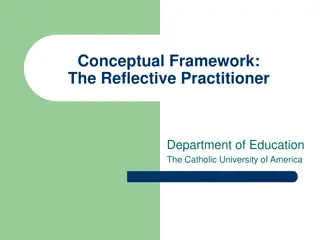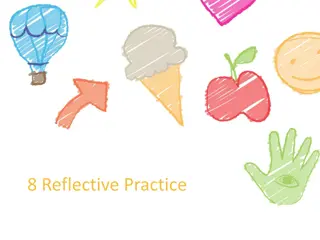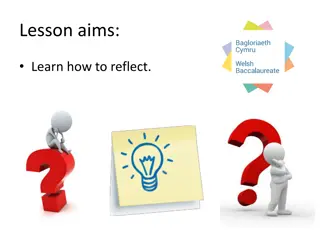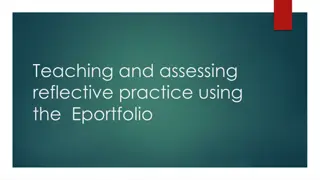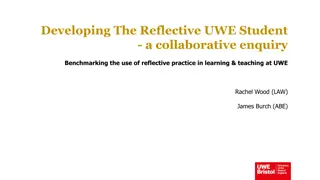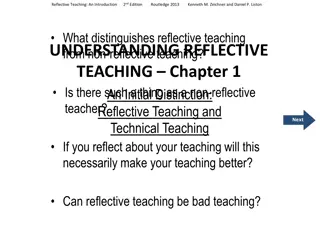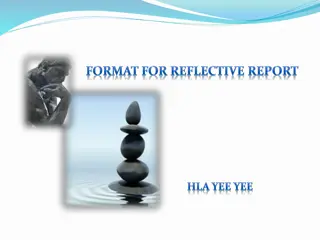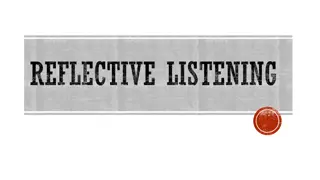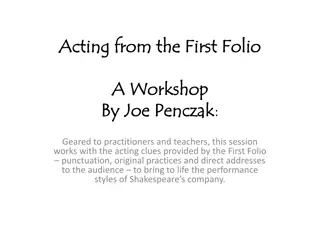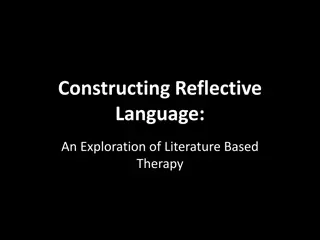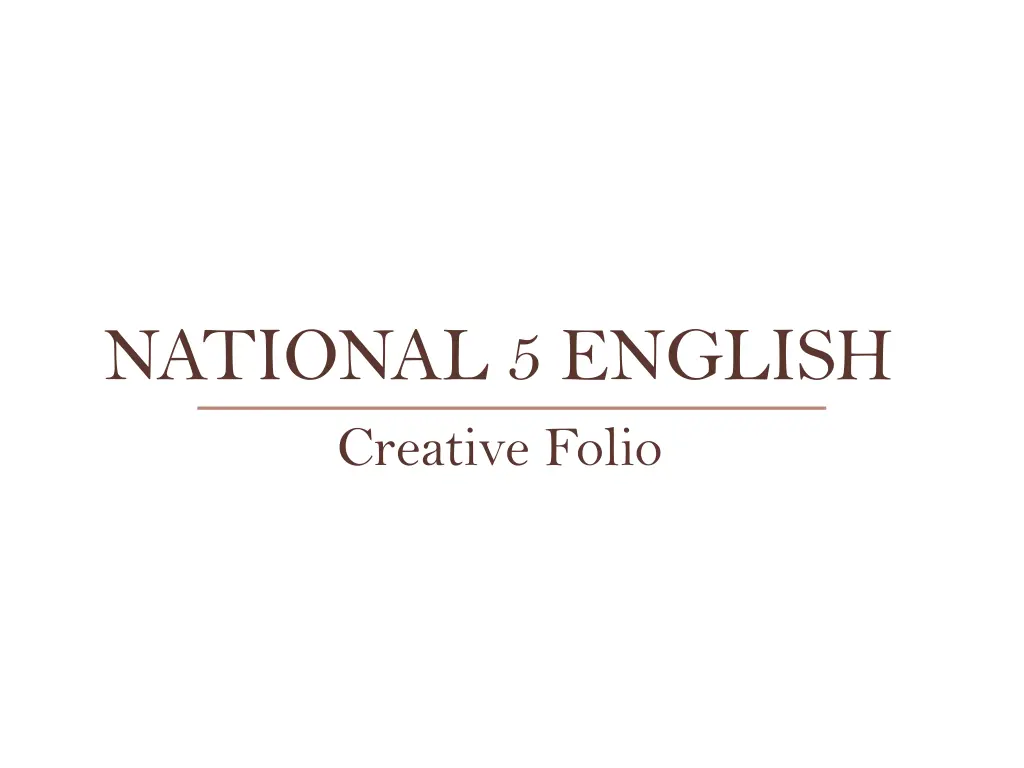
Crafting a Personal Reflective Essay for National 5 English Creative Folio
Delve into the art of writing a personal reflective essay for your National 5 English Creative Folio, exploring the intricacies of deep reflection and emotional expression. Learn how to infuse your experiences with authenticity and insight to captivate readers and earn a passing grade. Avoid common pitfalls and discover the power of thoughtful reflection in crafting a compelling narrative.
Download Presentation

Please find below an Image/Link to download the presentation.
The content on the website is provided AS IS for your information and personal use only. It may not be sold, licensed, or shared on other websites without obtaining consent from the author. If you encounter any issues during the download, it is possible that the publisher has removed the file from their server.
You are allowed to download the files provided on this website for personal or commercial use, subject to the condition that they are used lawfully. All files are the property of their respective owners.
The content on the website is provided AS IS for your information and personal use only. It may not be sold, licensed, or shared on other websites without obtaining consent from the author.
E N D
Presentation Transcript
NATIONAL 5 ENGLISH Creative Folio
First Folio Piece Broadly creative (personal or imaginative). Should be between 700 and 1000 words. Worth 15 marks. Plagiarism will be caught either by your teacher or the SQA, so don t take the risk! You will get the opportunity to redraft following feedback from your teacher.
Personal or Imaginative? You should only write a personal piece if you feel you ve got a subject you can discuss in depth and reflect upon in a detailed way. Writing about a time you went to Nando s or to Silverburn will probably not give you the opportunity to reflect and share your experiences in a way that will get you a pass in your folio! This PowerPoint will take you through what you need in order to write a successful personal reflective folio piece.
Personal Reflective Essay Personal reflective writing means writing about your reaction to something that has happened to you. It is usually about one single idea or experience and will always include reflection about what has happened and your feelings about it (or your feelings at different stages). It can be a tough thing to do - to look back on something that happened in the past and think about how you feel now. It s your thoughts and feelings about the experience that will make your writing original and fresh.
Personal Reflective Essay One common mistake with this type of writing is making it too narrative, i.e. too much story-telling and not enough reflection or reaction. You must show through your writing that you have thought about your experiences and have learned from them in some way. This reflection is what makes the writing interesting otherwise your essay will just be another account of someone going on holiday or entering a football competition.
A Good Start Getting your essay off to a strong start is vital. The beginning of an essay is important because it sets the tone and hooks the reader in. You are now going to look at the opening of a piece of non-fiction work and analyse its effectiveness.
Opening Paragraph 1 I woke up in hospital with my leg all in plaster. It was really sore and it was itchy too. My mum and dad had to come and get me. I had to go back to school the next week which wasn t much fun.
Questions 1. Can you identify any discussion of thoughts and feelings in this paragraph? Write these down. 2. Is there any reflection on the experience? 3. Does this paragraph effectively hook you in as a reader? Does it set a particular tone? You will now analyse a different opening paragraph, exploring the same topic.
Opening Paragraph 2 I slowly opened my eyes as if from a deep sleep. I yawned and stretched, expecting to see the familiar pink curtains draping my bedroom window. Instead, my gaze rested on a clinical blue fabric pulled round the trolley I was lying on. Was I still dreaming? Could I really be in hospital? Then it all started coming back to me bit by bit the kerb, the parked car, the crash! What a shock to see my leg all covered in plaster! It was really sore but I tried desperately not to cry. I didn t want the nurses to think I was a baby. When I think back it was the itching that really got me not the pain. I was so glad to see my mum and dad when they came to fetch me. I couldn t hold back my tears any longer; my mum looked so worried when she saw me. It was difficult going back to school with everyone staring at me. At first I felt so awkward, like a stranger lost in a big city, but gradually I got used to it and people grew used to the sight of me hobbling around the corridors
Questions 1. Can you identify any discussion of thoughts and feelings in this paragraph? Write these down. 2. Is there any reflection on the experience? 3. Does this paragraph effectively hook you in as a reader? Does it set a particular tone? 4. How does the writer use descriptive language in this opening? What is the effect of this?
Questions on both passages 1. Which of these two passages is better? 2. Why do you think this?
A Good Start Paragraph 1 is a very basic essay opening, with very little discussion of thoughts and feelings and no reflection. It is not particularly interesting and it uses basic language and very little description. Passage 2 is more detailed, descriptive and interesting to read. It shows an ability to paint a picture for the reader through use of language and is detailed and reflective. Try to aim for an opening more like passage 2 than passage 1.
A Good Start A common mistake when writing a personal piece is to start with a boring narrative introduction, as we have seen. So, how can you make your essay stand out and make your reader want to keep reading to find out what happens next? There are several techniques you could consider, such as opening with a flashback, a question, or dialogue, but most importantly you must focus on capturing the attention of your reader.
A Good Start - Task Read the opening paragraph on the next slide. Then, try to rewrite it to make it more engaging and interesting. Consider everything that has been mentioned already descriptive language, thoughts and feelings, reflection, strong opening line, etc.
An experience I will always remember is when me, my mum, my dad and my little brother all went on holiday to Mallorca. I had never been so excited in my life. When we got to the airport I was really excited. I had never been on a plane before and couldn t wait to take off. We had to wait for ages in the departure lounge and it was really boring. Finally they announced our flight and we all got on the plane. I was really excited but I was also nervous as I had never flown before and didn t know what to expect.
Vocabulary and Word Choice To make your writing more engaging it s important to use a varied vocabulary to help express yourself. Choose words which carry as much meaning as possible. For example, instead of using smile , you could use smirk , grin , or sneer . What is the difference between these words in terms of what they suggest?
Vocabulary and Word Choice - Questions 1. What does the word denotation mean? 2. What does the word connotation mean?
Vocabulary and Word Choice -Answers The denotation of a word is the literal definition of a word. For example, the word sun literally means the large, light-giving star around which the earth orbits . The connotations of a word are the thoughts and feelings associated with that word. For example, the connotations of sun could be summer, ice cream, holidays, the beach, sunburn, etc.
Vocabulary and Word Choice -Task Write down the denotation and connotations of the following words: Lazy Winter House Slender School Thrifty
Vocabulary and Word Choice It s important that you choose words and phrases in your essay which evoke the meaning (both the denotation and connotations) that you want to achieve. The best way to improve your vocabulary and understanding of language is to read try to find examples of personal essays written by other people to help you get an understanding of the genre. Authors you could explore include George Orwell, David Sedaris, and David Foster Wallace. You can also access personal essays on websites like The New Yorker. (https://www.newyorker.com/tag/personal- essays)
Figurative Language In addition to good vocabulary and word choice, a strong piece of personal writing should also include a range of figurative language, such as metaphors, similes or personification. You can also use sound techniques like alliteration and onomatopoeia to make your writing as engaging as possible. Figurative language will help your reader imagine the scene you are trying to create in much greater detail. The following tasks should help refresh your memory.
Simile 1.What is a simile? Write down the definition. 2.Write down an example which will help you remember. 3.Describe the images revealed in the following similes: 1. The room was as cold as ice. 2. Her eyes were like sapphires. 3. His grip on the bat was like a vice.
Metaphor 1. What is a metaphor? Write down the definition. 2. Write down an example which will help you remember. 3. Make up metaphors to help describe these characters: 1. An old person 2. Somebody who moves slowly 3. Somebody who moves very quickly
Personification 1. What is personification? Write down a definition. 2. What atmosphere do these examples create: 1. The river murmured softly. 2. The walls listened intently. 3. The trees sighed gently. 3. Write down an example which will help you remember the definition of personification.
Alliteration 1. Write down a definition of alliteration. 2. Write down an example of alliteration. 3. Why might you include alliteration in your writing? 4. Try to create alliterative descriptions for the following: 1. Grass 2. Sand 3. The sky
Onomatopoeia 1. Write down a definition of onomatopoeia. 2. What does onomatopoeia help add to a piece of writing? 3. Add as many words as you can to the following examples of onomatopoeia: scrape, crunch, bang, crash, crack 4. Create a descriptive sentence including at least two examples of onomatopoeia.
The Senses What are the five senses? Sight Sound Smell Taste Touch
The Five Senses - Task I tumbled towards the floor, crashing down on my ankle. I heard a terrible snap and felt a shocking pain seizing my leg. I had that terrible sensation of tasting my own blood in my mouth I must have bitten my tongue as I collapsed. I glanced at my broken joint and was overcome with a wave of nausea as I realised my once straight and slender ankle was bent like a boomerang. Write down every example of sensory description you can find in this paragraph.
Using the Five Senses - Task Using the five senses, develop the following sentences below into a short descriptive paragraph. For example, the paragraph on the previous page was developed from the sentence I hurt my ankle. 1. I won a competition 2. I could not fall asleep 3. I was almost hit by a car
Reflection Throughout your essay, you should be describing your thoughts and feelings as you look back on the event you are describing. Then, at the end of the essay, you should give a detailed reflection of the experience you have discussed. In order to reflect, you should be looking back on what happened, considering how it affected you, and thinking about what you learned from the experience. The following slide has a list of questions you can use to help you reflect on your experience.
Reflective Questions 1. What emotions did I feel? Why? 2. What is the meaning of this experience? How do I know this? 3. How does this make me think about the future? 4. Have I changed because of this? How? Is this good or bad? 5. In what way was this a turning point for me? 6. What could I have done differently? 7. How can I use this experience to help someone else? 8. How has this changed the way I think?
Reflective Questions - Task Using the questions on the previous slide, think about an important experience you have had, or a time you experienced a significant emotion, and try to write a paragraph of reflection about it.
Personal Reflective Essay Success Criteria What do you need to do in order to write a successful personal essay? Write an engaging opening paragraph which hooks your readers in 1. Use figurative language and sensory description throughout to make your writing interesting and detailed 2. Discuss your thoughts and feelings throughout your essay 3. Reflect on your experiences in your conclusion 4. Remember your essay should be between 700 and 1000 words.




